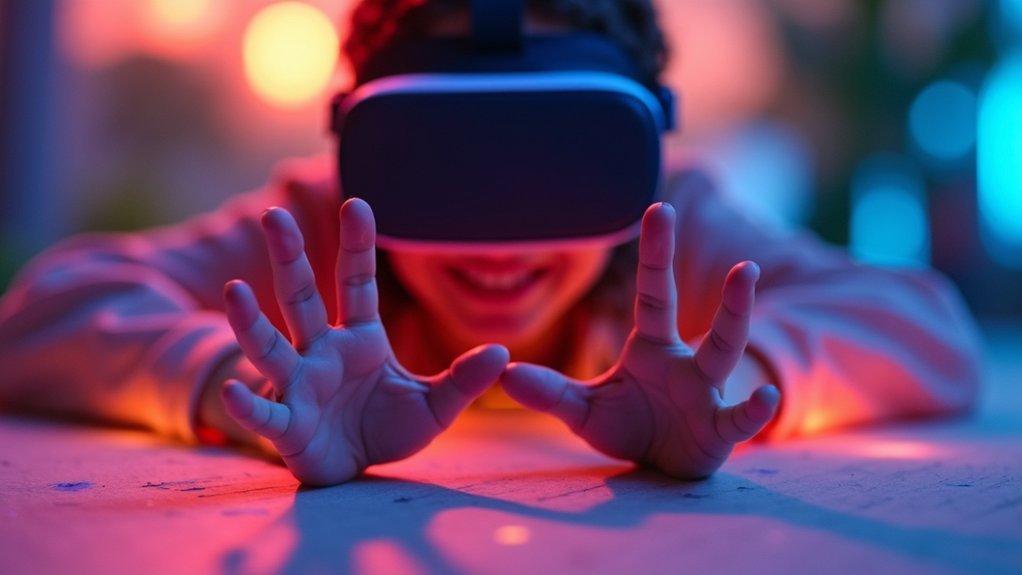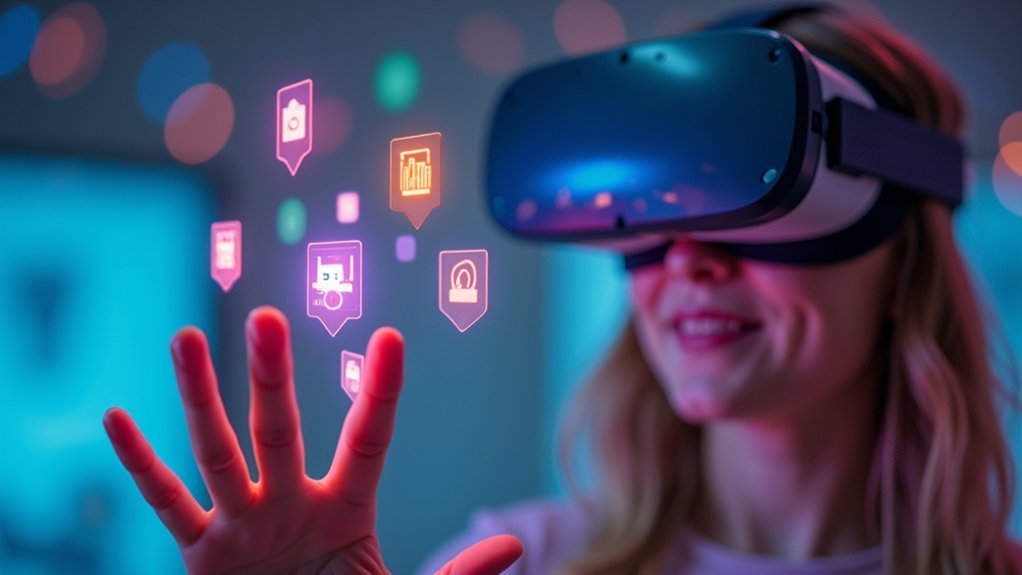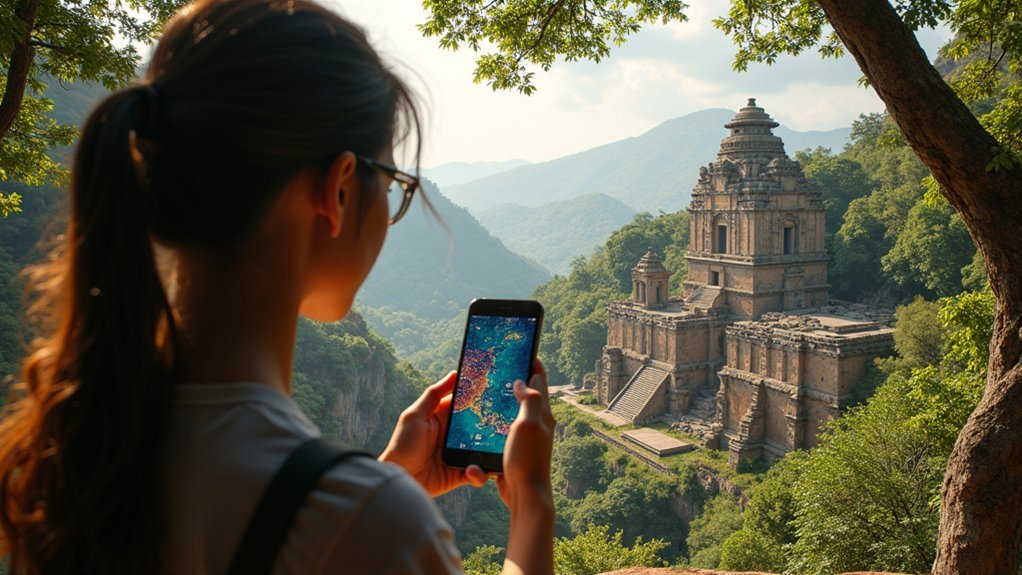You’ll choose Oculus Quest’s hand tracking because it creates natural, controller-free VR experiences that mirror real-world interactions. Advanced computer vision algorithms detect your hand movements with impressive accuracy, translating gestures like pointing, grabbing, and swiping into seamless virtual actions. The Hands 2.2 upgrade reduces latency by up to 40%, while auto-switching between controllers and hands enhances convenience. This intuitive technology eliminates learning curves and makes VR accessible to newcomers seeking authentic immersion. Discover how this revolutionary feature transforms your virtual adventures.
Enhanced Immersion Through Natural Hand Movements

When you move your hands naturally in virtual reality, the Oculus Quest’s hand tracking technology transforms these gestures into seamless interactions that dramatically enhance your sense of presence.
You’ll find yourself pointing, grabbing, and swiping without thinking twice about controllers or buttons. This natural and intuitive approach creates an immersive experience that feels remarkably authentic.
The advanced computer vision algorithms accurately detect your hand position and finger configurations, making every movement count.
Precision computer vision technology captures every subtle hand movement and finger gesture, translating natural motion into accurate virtual interaction.
You can pinch and drag to scroll through menus or use palm pinch to access the universal menu.
With hand tracking, your virtual interactions mirror real-world movements, eliminating the barrier between you and the digital environment.
This technology makes VR feel less like using a device and more like inhabiting another world.
Eliminating Controller Dependencies for Seamless Interaction
You’ll discover that hand tracking frees you from the constraints of physical controllers, letting you interact with virtual environments using only your natural hand movements.
Your gaming sessions become more fluid as you point, pinch, and gesture without fumbling for buttons or worrying about controller battery life.
This controller-free approach transforms how you navigate menus and manipulate objects, creating an intuitive experience that feels as natural as real-world interactions.
Natural Hand Gestures
How naturally can you interact with virtual worlds when your hands become the primary interface?
With hand tracking on Oculus Quest, you’ll discover that natural gestures transform your VR experience into something remarkably intuitive. You can point at objects to select them, pinch items to grab them, and scroll through content just like you’d on a smartphone—all without ever touching a physical controller.
The technology recognizes specific movements like Palm Pinch for maneuvering menus and Pinch and Scroll for browsing content.
These gestures mirror your real-world actions, making the virtual environment feel more authentic and accessible. You’ll find yourself interacting with digital elements as naturally as you’d with physical objects, creating a seamless bridge between reality and virtual space.
Controller-Free Gaming Experience
As hand tracking eliminates the need for physical controllers, you’re free to engage with virtual worlds through pure hand movements that feel completely natural. This controller-free experience transforms how you interact with VR environments, making gameplay more intuitive and immersive.
| Traditional VR | Hand Tracking |
|---|---|
| Requires controllers | Controller-free interaction |
| Learning button layouts | Natural hand gestures |
| Physical device management | Zero hardware dependencies |
You’ll discover that controller-free gaming opens up new possibilities for interaction. Advanced computer vision algorithms detect your hand position and orientation in real-time, allowing you to point, grab, pinch, and scroll without any physical input devices. The auto switch feature seamlessly shifts between hand tracking and controllers when needed, adapting to your preferences while maintaining fluid gameplay.
Computer Vision Technology Behind Hand Detection
When you activate hand tracking on your Oculus Quest, the headset’s inside-out cameras capture real-time images of your hands and process them through sophisticated computer vision algorithms.
The system analyzes these images at lightning speed, determining your hand’s position, orientation, and individual finger configurations with remarkable precision.
You’ll experience this advanced technology as it estimates each finger’s exact position and translates your natural gestures into actionable commands within the virtual environment.
Camera-Based Image Processing
While you slip on your Oculus Quest headset, four strategically positioned inside-out cameras immediately begin capturing real-time images of your hands, transforming these visual inputs through sophisticated computer vision algorithms that can detect even the subtlest finger movements.
You’ll experience remarkably precise hand tracking as the system processes visual data in real-time, analyzing each captured frame to recognize individual finger configurations and hand orientations.
This camera-based approach delivers impressive latency reduction—up to 40% during typical usage and 75% during fast movements with the Hands 2.2 Upgrade.
You’re getting accuracy comparable to high-end devices like Leap Motion, while the elimination of physical controllers creates a more immersive, intuitive virtual environment where your natural hand gestures become seamless interaction tools.
Real-Time Algorithm Analysis
The Oculus Quest’s hand tracking engine employs a sophisticated neural network architecture that processes thousands of data points per second, analyzing pixel patterns to construct detailed 3D models of your hands in real-time.
These computer vision algorithms continuously examine real-time images captured by the headset’s cameras, identifying key landmarks like fingertips, joints, and palm positions. The system’s machine learning models have been trained on millions of hand configurations, enabling accurate recognition of complex gestures and finger movements.
You’ll experience remarkably low latency thanks to optimized processing pipelines that reduce delays by 40% during normal use and 75% during rapid movements.
This advanced hand tracking technology transforms visual data into precise spatial coordinates, allowing you to interact naturally with virtual environments without external hardware.
Finger Position Estimation
Beyond identifying your hands as complete objects, Oculus Quest’s computer vision system breaks down each finger into precise coordinate points through sophisticated landmark detection algorithms.
This finger position estimation process transforms raw camera data into actionable 3D coordinates for each joint and fingertip.
The system’s advanced techniques enable it to accurately detect various gesture patterns:
- Pointing gestures – Isolated finger extension detection
- Pinching motions – Thumb-to-finger contact recognition
- Scrolling movements – Multi-finger directional tracking
- Complex manipulations – Full hand pose interpretation
You’ll experience hand tracking accuracy that rivals industry-leading solutions like Leap Motion.
The algorithms continuously analyze finger relationships and joint positioning, ensuring your virtual interactions feel natural and responsive.
However, performance can decline when your hands overlap or occlude each other during complex movements.
Supported Gestures for Virtual Environment Navigation
When you enable hand tracking on your Oculus Quest, you’ll discover a range of intuitive gestures that transform how you navigate virtual environments. These natural movements eliminate controller dependency while maintaining precise interaction capabilities.
| Gesture | Action | Function |
|---|---|---|
| Point and Pinch | Selection | Open apps and make selections |
| Pinch and Scroll | Navigation | Move through content seamlessly |
| Palm Pinch | Menu Access | Return to Universal Menu |
| Touch | Direct Interaction | Type and interact with UI elements |
Your hand tracking experience becomes remarkably fluid through these gestures. You’ll pinch your thumb and index finger together for quick menu access, while pinch-and-scroll motions let you navigate content effortlessly. Touch gestures enable direct typing and UI interaction, creating an immersive experience that feels natural and responsive in any virtual environment.
Quick Setup Process and Settings Configuration
You’ll start the Hand Tracking setup process by pressing the Meta/Oculus button to access the universal menu on your Quest headset.
Navigate to Quick Settings by hovering over the clock icon, then open Settings from the top right corner.
Select Device and choose Hands and Controllers to toggle Hand Tracking on or off based on your preferences.
Accessing Universal Menu
Since the hand tracking feature requires proper configuration through your Oculus Quest’s settings, you’ll need to navigate to the Universal Menu first. This essential interface serves as your gateway to customizing the hand tracking functionality and other device preferences.
To access the Universal Menu and configure your hand tracking settings:
- Press the Meta/Oculus button on your right Touch controller to open the Universal Menu
- Hover over the clock icon located on the left side to reveal the Quick Settings panel
- Select the gear icon in the top right corner to enter the main Settings menu
- Navigate to Device section and choose Hands and Controllers for configuration options
Once you’re in the Hands and Controllers section, you can toggle hand tracking on or off within the Movement tracking settings based on your preferences.
Toggling Hand Tracking
After reaching the Hands and Controllers section, you’ll find the Hand Tracking toggle within the Movement tracking settings. Toggling hand tracking is straightforward—simply switch it on or off based on your preferences.
You can enable and disable hand tracking manually whenever needed, giving you complete control over your interaction method.
The auto switch for hand functionality offers enhanced convenience by automatically detecting whether you’re using controllers or hands. When enabled, your headset seamlessly shifts between tracking modes without manual intervention.
This feature proves particularly useful during extended gaming sessions where you might alternate between different interaction methods.
If you prefer maintaining full control, you can disable the auto switch feature and manually activate hand tracking through the settings menu whenever desired.
Auto Switch Feature Benefits and Functionality
Seamless shifts between hand tracking and controller input become effortless with the Auto Switch feature on Oculus Quest.
This intelligent system automatically detects when you put down or pick up your controllers, eliminating manual toggling and creating uninterrupted VR sessions.
The Auto Switch functionality delivers these key advantages:
- Automatic detection – Your headset instantly recognizes when controllers aren’t in use and switches to hand tracking mode
- Enhanced convenience – You’ll experience streamlined interactions without needing to manually change input methods
- Flexible control – You can disable this feature if you prefer manual switching between hand tracking and controllers
- Improved immersion – Natural interactions flow without interruptions from switching input methods
This enhancement, introduced in major updates, greatly improves responsiveness and user engagement across VR applications.
Improved Responsiveness With Hands 2.2 Upgrade
When Meta released the Hands 2.2 upgrade for Quest headsets, hand tracking responsiveness reached new performance heights with up to 40% latency reduction in typical usage scenarios.
You’ll experience even more dramatic improvements during fast movements, with latency dropping by an impressive 75%. This enhanced responsiveness transforms your interaction with dynamic VR environments.
The upgrade introduces Fast Motion Mode (FMM), specifically engineered for fast-paced games where precise movement tracking is essential.
You can test these capabilities using the Move Fast demo app, which demonstrates the improved responsiveness in real-time.
Best of all, you don’t need to take any additional steps beyond updating your headset to version 56. This seamless upgrade makes enhanced hand tracking performance instantly accessible to all Quest users.
Fast Motion Mode for High-Intensity Applications
You’ll experience dramatically reduced latency with Fast Motion Mode, which cuts response delays by up to 75% during rapid hand movements.
This enhanced responsiveness makes FMM particularly valuable for fitness and rhythm applications where split-second timing matters.
Developers can easily integrate this technology into Unity, Unreal, and native applications using the extensive documentation provided.
Latency Reduction Benefits
Although traditional hand tracking can struggle with rapid movements, the Fast Motion Mode (FMM) introduced with Hands 2.2 dramatically changes the game by reducing latency up to 40% in typical scenarios and an impressive 75% during fast movements.
This latency reduction transforms your VR experience in several key ways:
- Precision Gaming: High-frequency tracking guarantees your actions execute exactly when intended in competitive games.
- Seamless Fitness Apps: Rapid workout movements register instantly without frustrating delays.
- Enhanced Immersion: Lag-free interactions maintain your sense of presence during intense sessions.
- Rhythm Game Excellence: Beat games become more responsive and enjoyable with precise timing.
Fast Motion Mode’s improved responsiveness makes hand tracking viable for applications that previously required controllers, opening new possibilities for immersive gaming and fitness experiences.
Fitness App Integration
Fast Motion Mode’s breakthrough performance makes it particularly valuable for fitness applications where every millisecond counts.
When you’re engaged in high-intensity workouts on your Meta Quest, you’ll experience up to 75% latency reduction during fast movements, ensuring your hand tracking responds instantly to rapid gestures and punches.
This high-frequency tracking transforms how you interact with fitness apps, eliminating the frustration of delayed responses during intense activities. You can throw punches, perform yoga poses, or execute dance moves with natural precision, creating truly immersive workout experiences without physical controllers.
Developers can utilize the open-source Move Fast demo app to test FMM capabilities and optimize their fitness applications.
With future enhancements planned, hand tracking technology continues evolving to meet demanding fitness environments.
Developer Implementation Resources
While implementing Fast Motion Mode requires technical precision, Meta provides extensive documentation and tools that streamline the integration process across Unity, Unreal, and Native development environments.
These developer implementation resources guarantee you can harness hand tracking capabilities efficiently for high-intensity applications.
The thorough support package includes:
- Move Fast Demo App – Open-source testing platform for evaluating FMM performance in your specific use cases
- Cross-Platform Documentation – Detailed integration guides for Unity, Unreal, and Native development workflows
- Performance Optimization Tools – Resources for maximizing the 40% latency reduction during typical usage and 75% improvement during rapid movements
- Development Environment Support – Seamless integration assistance across all major VR development platforms
Fast Motion Mode transforms your fitness and rhythm applications by delivering responsive, immersive experiences that keep users engaged through precise movement tracking.
Multimodal Tracking Capabilities and Advantages
Beyond traditional single-mode tracking systems, the Oculus Quest’s multimodal capabilities let you seamlessly blend hand gestures with controller inputs during the same session.
You’ll experience enhanced social presence as natural hand gestures complement your controller use, making interactions feel remarkably lifelike.
The auto switch feature automatically detects when you set down or pick up controllers, streamlining your experience without gameplay interruption.
Experience seamless transitions between hand tracking and controllers with intelligent auto-detection that keeps you immersed in your virtual world.
You can fluidly shift between input methods based on your preferences and interaction context, whether you’re engaged in casual gaming or fitness applications.
This multimodal tracking greatly improves responsiveness and user engagement across diverse applications.
You’ll find that simultaneous use of both hands and controllers creates a more immersive experience, allowing you to maintain natural movement patterns while accessing precise controller functionality when needed.
Privacy Considerations and Data Protection Measures
When you enable hand tracking on your Oculus Quest, you’re entrusting Meta with sensitive biometric data that requires careful protection.
Meta implements extensive data protection measures to safeguard your privacy during Hand Tracking interactions.
The privacy framework includes several key protections:
- Real-time processing – Hand Tracking analyzes your movements in real-time without storing personal images on devices
- Minimal data collection – Only necessary interaction data is collected, reducing potential exposure of personal information
- Advanced algorithms – Computer vision technology tracks hand positions while maintaining strict privacy protocols
- Transparent policies – The Hand and Body Privacy Notice clearly outlines what data is collected and how it’s handled
You should review Meta’s privacy policies to understand these protections fully and confirm you’re comfortable with the data handling practices before enabling Hand Tracking features.
Performance Accuracy and Tracking Limitations
After understanding the privacy protections in place, you’ll want to know how well hand tracking actually performs in practice.
The Oculus Quest delivers impressive accuracy in detecting hand shapes and individual finger movements, creating natural interactions that feel intuitive. You’ll find the performance comparable to specialized devices like Leap Motion.
The Oculus Quest achieves remarkable hand tracking precision, delivering intuitive finger detection that rivals dedicated motion sensing hardware like Leap Motion.
However, tracking limitations do exist. When your hands overlap or touch each other, you’ll experience temporary tracking loss. Fast movements can also cause brief interruptions, though the system recovers quickly.
The 80ms latency in virtual hand movements becomes noticeable during fast-paced scenarios. Bimanual interactions present the most significant challenge, requiring further development before reaching full interactive application potential.
User Experience Benefits for VR Newcomers
Despite these tracking constraints, hand tracking transforms the VR experience for newcomers by eliminating the intimidation factor of complex controllers.
You’ll discover a more intuitive interaction method that feels natural and familiar, making your first VR experience less overwhelming.
The user experience benefits include:
- Natural gesture integration – pointing and pinching motions provide fluid navigation that you already understand
- Reduced learning curve – you can engage immediately without memorizing button layouts or controller mechanics
- Seamless input switching – auto switch feature lets you shift between hand and controller inputs effortlessly
- Improved responsiveness – 40% reduced latency creates more realistic and immediate interactions
This intuitive interaction approach accelerates your onboarding process, helping you adapt to virtual environments with confidence rather than confusion.
Developer Integration Opportunities and Resources
While VR newcomers benefit from hand tracking’s intuitive design, developers gain access to powerful tools and resources that reveal advanced implementation possibilities. You can leverage Fast Motion Mode for up to 75% latency reduction in fitness and rhythm applications, creating more responsive experiences during rapid movements.
| Feature | Application | Benefit | Platform Support |
|---|---|---|---|
| Fast Motion Mode | Fitness/Rhythm Apps | 75% latency reduction | Unity/Unreal/Native |
| Multimodal Tracking | Social Applications | Seamless hand-controller shifts | All platforms |
| Open-source Documentation | Move Fast Demo | Implementation guidelines | Cross-platform |
| Extensive Integration | VR Experiences | Easy hand tracking setup | Unity/Unreal/Native |
The Multimodal feature enables simultaneous hand and controller tracking, enhancing social presence through seamless shifts. Open-source documentation and extensive guidelines support effective developer integration across Unity, Unreal, and Native platforms, with future upgrades planned.
Future Developments and Technology Roadmap
Meta’s roadmap for Hand Tracking technology promises significant enhancements that’ll transform how you interact with virtual environments.
These future developments address current limitations while expanding capabilities for diverse applications.
Key improvements you can expect include:
- Enhanced responsiveness and accuracy – Particularly for bimanual interactions and fast movement scenarios
- Fast Motion Mode (FMM) integration – Optimized for fitness and rhythm applications requiring high-intensity responsiveness
- Refined tracking precision – Addressing limitations observed in rapid hand movements
- Touch Pro compatibility – Seamless integration with advanced controller features
Meta actively encourages developers to incorporate Hand Tracking features, fostering innovation within the community.
Upcoming events like Meta Connect will reveal additional advancements, keeping you informed about cutting-edge developments that’ll enhance your virtual reality experience through improved hand-based interactions.
Frequently Asked Questions
Is Hand Tracking Good on Quest 2?
You’ll find hand tracking on Quest 2 performs well with 40% less latency and intuitive gestures like pinch navigation. It’s immersive and controller-free, though you might experience fatigue during extended sessions.
How Accurate Is Meta Quest Hand Tracking?
You’ll find Meta Quest hand tracking highly accurate for individual finger movements and hand positioning. However, you’ll experience reduced performance when your hands overlap, and you might notice temporary tracking loss during rapid movements.
How Does Oculus Hand Tracking Work?
Your Quest headset’s inside-out cameras capture real-time images of your hands. Computer vision algorithms analyze hand positions, orientations, and finger movements, translating them into virtual interactions without needing physical controllers.
Why Is My Quest 2 Tracking so Bad?
Your Quest 2 tracking’s probably bad due to poor lighting, fast movements, hands too far from cameras, or hand occlusion. Try better lighting, stay within ideal range, and enable Fast Motion Mode.
In Summary
You’ll discover that hand tracking transforms your Quest experience by removing barriers between you and virtual worlds. You’re no longer tethered to controllers, making interactions feel natural and intuitive. While there’s room for improvement in accuracy, you’ll appreciate the seamless setup and enhanced immersion. Whether you’re a newcomer or developer, hand tracking opens new possibilities for creating and experiencing VR content that feels genuinely magical.





Leave a Reply